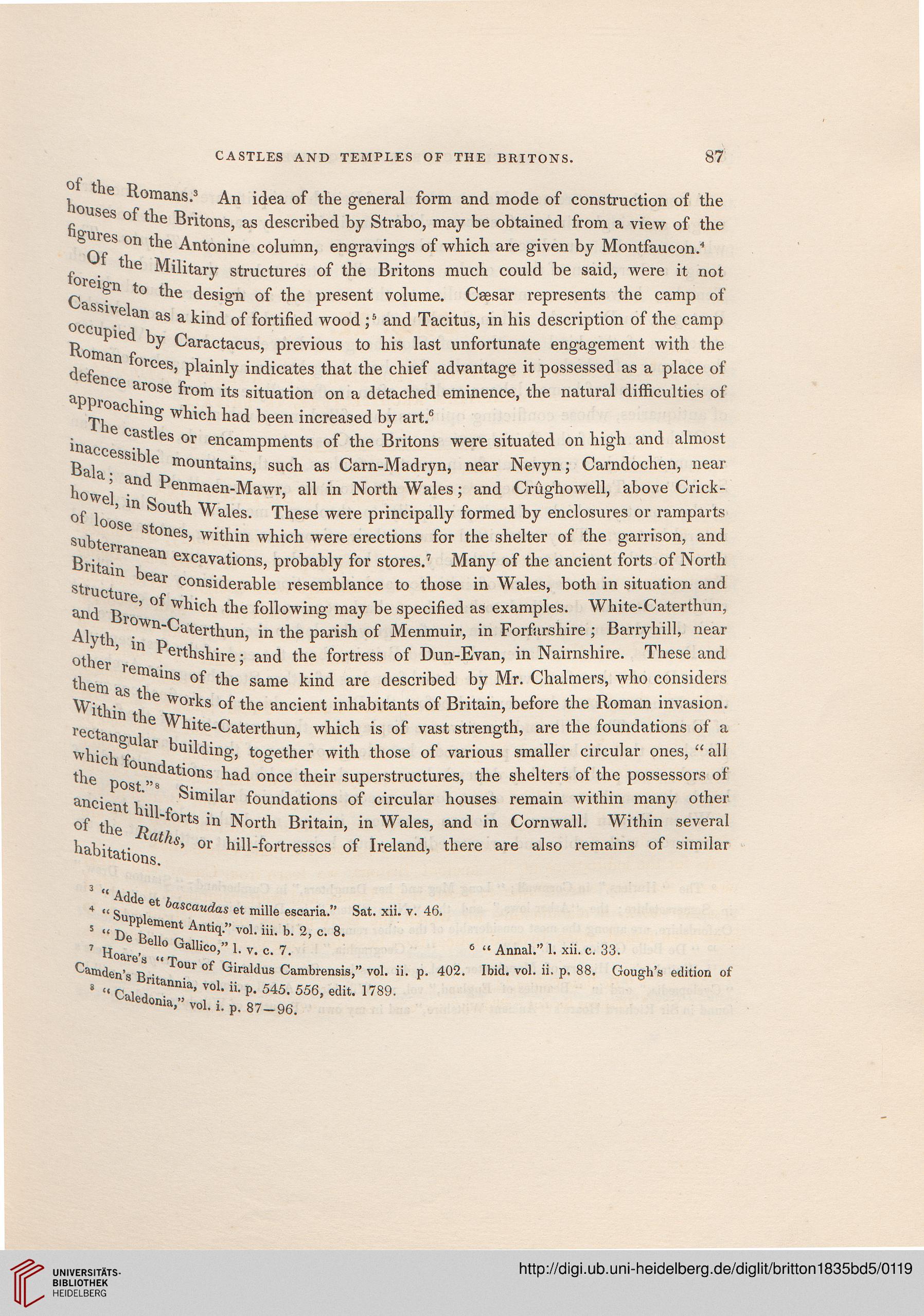CASTLES AND TEMPLES OF THE BRITONS. 87
Of the Rn
hou omans-3 An idea of the general form and mode of construction of the
Ses °f the Britons, as described by Strabo, may be obtained from a view of the
q^S on tne Antonine column, engravings of which are given by Montfaucon.4
the Military structures of the Britons much could be said, were it not
Ca ° design of the present volume. Ceesar represents the camp of
0ccu^e^n as a kind of fortified wood ;5 and Tacitus, in his description of the camp
Y{QTn 16 ky Caractacus, previous to his last unfortunate engagement with the
defer^11 ^°rces' Painty indicates that the chief advantage it possessed as a place of
aPDr ^rose frorn its situation on a detached eminence, the natural difficulties of
^ oachmg which had been increased by art.6
inac °astles or encampments of the Britons were situated on high and almost
p,a)a, e m°untains, such as Carn-Madryn, near Nevyn; Carndochen, near
howe'l Penmaen_Mawr> a11 in North Wales; and Crughowell, above Crick-
°f loose0 ^°Ut^ ^a^es- These were principally formed by enclosures or ramparts
subter Stones' within which were erections for the shelter of the garrison, and
Britain eXcavations> probably for stores.7 Many of the ancient forts of North
structur F Cons^erable resemblance to those in Wales, both in situation and
and B 6' °^ W^^°h the following may be specified as examples. White-Caterthun,
Alyth r°Wn ^aterthun, in the parish of Menmuir, in Forfarshire ; Barryhill, near
otL ' ln ^erthshire; and the fortress of Dun-Evan, in Nairnshire. These and
r remair
them asCt"ainS °^ ^e same ^hid are described by Mr. Chalmers, who considers
Within th ^ W°r^s °^ the ancient inhabitants of Britain, before the Roman invasion.
rectangul 6 ^^.'te-Caterthun, which is of vast strength, are the foundations of a
which fou^^^11^' together with those of various smaller circular ones, " all
the post "s a*10ns had once their superstructures, the shelters of the possessors of
ancient hill ^m^ar foundations of circular houses remain within many other
«vP ii forts in North Tlritain in W^loa anrl in f~!r»mwall Within spvprnl
°f the p ^/.°rtS m ^°rth Britain, in Wales, and in Cornwall. Within several
Stations.
habitat" ^at^s> or hill-fortresscs of Ireland, there are also remains of similar
4 " Sn^i6* bascaudas et mille escaria." Sat. xii. v. 46.
5''De ?rntAntiq-''VOl-iii-b-2'c- 8-
7 H<w Gallic°." I- v. c. 7. 6 " Annal." 1. xii. c. 33.
^mden's B "t UF ° iraldus Cambrensis," vol. ii. p. 402. Ibid. vol. ii. p. 88. Gough's edition of
8,,Caledoln^;OUlp'545-556'edit-17^
ma» vol. i. p, 87—96.
Of the Rn
hou omans-3 An idea of the general form and mode of construction of the
Ses °f the Britons, as described by Strabo, may be obtained from a view of the
q^S on tne Antonine column, engravings of which are given by Montfaucon.4
the Military structures of the Britons much could be said, were it not
Ca ° design of the present volume. Ceesar represents the camp of
0ccu^e^n as a kind of fortified wood ;5 and Tacitus, in his description of the camp
Y{QTn 16 ky Caractacus, previous to his last unfortunate engagement with the
defer^11 ^°rces' Painty indicates that the chief advantage it possessed as a place of
aPDr ^rose frorn its situation on a detached eminence, the natural difficulties of
^ oachmg which had been increased by art.6
inac °astles or encampments of the Britons were situated on high and almost
p,a)a, e m°untains, such as Carn-Madryn, near Nevyn; Carndochen, near
howe'l Penmaen_Mawr> a11 in North Wales; and Crughowell, above Crick-
°f loose0 ^°Ut^ ^a^es- These were principally formed by enclosures or ramparts
subter Stones' within which were erections for the shelter of the garrison, and
Britain eXcavations> probably for stores.7 Many of the ancient forts of North
structur F Cons^erable resemblance to those in Wales, both in situation and
and B 6' °^ W^^°h the following may be specified as examples. White-Caterthun,
Alyth r°Wn ^aterthun, in the parish of Menmuir, in Forfarshire ; Barryhill, near
otL ' ln ^erthshire; and the fortress of Dun-Evan, in Nairnshire. These and
r remair
them asCt"ainS °^ ^e same ^hid are described by Mr. Chalmers, who considers
Within th ^ W°r^s °^ the ancient inhabitants of Britain, before the Roman invasion.
rectangul 6 ^^.'te-Caterthun, which is of vast strength, are the foundations of a
which fou^^^11^' together with those of various smaller circular ones, " all
the post "s a*10ns had once their superstructures, the shelters of the possessors of
ancient hill ^m^ar foundations of circular houses remain within many other
«vP ii forts in North Tlritain in W^loa anrl in f~!r»mwall Within spvprnl
°f the p ^/.°rtS m ^°rth Britain, in Wales, and in Cornwall. Within several
Stations.
habitat" ^at^s> or hill-fortresscs of Ireland, there are also remains of similar
4 " Sn^i6* bascaudas et mille escaria." Sat. xii. v. 46.
5''De ?rntAntiq-''VOl-iii-b-2'c- 8-
7 H<w Gallic°." I- v. c. 7. 6 " Annal." 1. xii. c. 33.
^mden's B "t UF ° iraldus Cambrensis," vol. ii. p. 402. Ibid. vol. ii. p. 88. Gough's edition of
8,,Caledoln^;OUlp'545-556'edit-17^
ma» vol. i. p, 87—96.




